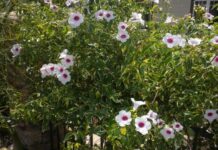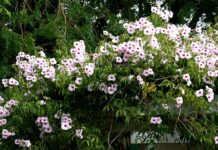
Split Rock plant or Pleiospilos nelii is a species of flowering plant in the family Aizoaceae, but it is not in the Lithops genus, as some believe. Lithops are similar, and they are also in the Aizoaceae family, but they are a separate genus.
The Pleiospilos genus, native to South Africa, contains well over 30 species, and as far as it is known, all have various degrees of speckling on the leaves. Split Rock is believed to have the most attractive markings of all of them.
Etymology and Alternative names
The name is derived from the Greek pleios “many” and spìlos “spot”. The plants are also known as kwaggavy (“Quagga mesemb”), lewerplant (“liver plant”), lewervygie (“liver mesemb”), klipplant (“stone plant”) or mimicry plant.
The species epithet nelii honours the South African botanist Gert Cornelius Nel. The common name “split rock” refers to the appearance of the plant’s leaves.
Split rock Plant: Appearance
Split Rock species have two or four opposite, very fleshy, dark grey-green leaves with many conspicuous raised dark dots, growing from a short stem that may be underground. The leaves, with their hemispherical shape and pitted texture, often strongly resemble a pile of split pebbles to deter predators.

Flowers emerge from the center of the leaves, and may be very big in relation to the overall size of the plant, they are very showy, orange, red and yellow and can grow up to 3 inches (7.5 cm) across.
Leaves will reach up to 2 inches (5 cm) long and wide. They are very easy to grow and very showy when in flower. The plants are hardy down to 23°F (-5°C). It grows ,natively, in semi-arid areas with rainfall of between 150mm and 300mm, in the Karoo of South Africa.
Watering tips
Make sure NOT to water on the plant itself. Water directly in the soil. You can use a cup or a glass to make sure the water does not spray on leaves. When watering, make sure water comes out of the drainage hole.
Environment
They grow in arid desert-like regions that get very little rainfall. They love sun so make sure they are in a south-facing window and when summer rolls around, let them get plenty of filtered light outdoors, plenty of ventilation and protect from rain.
Split rock plant need full sun to light shade with a very well-drained soil mix. The container should be at least 5 inches (12.7 cm) deep to accommodate the long tap root. (Since the split rock has such a long tap root, the pot should be deep accordingly).
Allow the soil to dry completely between waterings . Hold back water during the hottest weeks of summer and also in the ead of winter. Proper drainage is a must so make sure the pot has a hole in the bottom.
Split Rock require a loam-based compost with the addition of extra drainage material such as horticultural grit or perlite.
Split rock plant: Propagation
Split Rock is propagated by division in early spring before new growth starts, after the winter dormancy period. One should not divide clumps too often because they bloom best when crowded. It can be reproduced both sexually and asexually. Vegetative offshoots emerge from the root system.
Split rock: Where to plant
Split rock plant (Pleiospilos nelii) is not cold hardy, so in case you stay in a zone which will get colder than 30° F (-1.1° C), it is better to grow this succulent in a container which may be brought inside. It does very well in full to partial sun.
Plant in sandy, well draining soil. “Split Rock” does well indoors on windowsills.
Repotting Split rock plant
Since Split Rocks are actually slow growers, repotting must just take place when every three to five years. To do this, just choose a brand new plant to transfer the plant of yours that is around 4 inches deep with a gap at the bottom part. This will need to provide adequate drainage to your Split Rock and allow its roots enough room to develop.
You might also plant your Split Rocks on the earth in the outside garden of yours. Only just be sure that the dirt you will be using and draining circumstances are ideal to stay away from rot as a result of improper drainage or perhaps freezing. The plant of yours may also enjoy it in case you’re adding some rocks in addition to the dirt of its, as this can make them believe at home.
Additionally, ensure to cover at least ⅓ of the stem of its in the earth, leaving ⅔, the same as the way a rock will sit on the earth.
When you’ve effectively transplanted your Split rock plant, it’s essential not to provide it any water for no less than a couple of days to a week to inspire the origins of its to get and adjust to its unique ground. After a week, you might water, but just as necessary.
Additionally, make certain not to disturb or even repot your Split Rock while it is still in the dormant time. Rather, do this before the plant begins its blooming cycle, that often occurs in early Spring
Temperature & Light
When it concerns light exposure, Split rock require partial shade to full sunshine to raise healthy and happy. Thus, in case you’re raising it indoors, you need to expose this particular plant to as much light as possible to flourish, particularly during Winter, as temperatures that are cool tend may have an effect on the plant’s all round well being.
A spot near a south facing window must meet this issue. When you do not have a south facing window or maybe any area in which your Split Rock is able to get adequate light, think about getting some grow lights.
You are able to also develop your Split Rock in the garden outside to have light that is brilliant, but be sure to keep it protected against the strong sun in the evening and rain. Additionally, remember this particular plant isn’t cold hardy.
And so in case you stay in a zone exactly where it becomes colder than thirty degrees Fahrenheit, we highly suggest raising it in a container or maybe pot exactly where they could quickly be brought inside as soon as the temperature begins dropping.
Tips
When dealing with a Split Rock it is recommended to use a soil mix consisting of 1 part peat moss to 1 part loam to 2 parts coarse sand with small pebbles added to ensure good drainage. Very little water is needed during the growing season, and we do not fertilize the plants.
Make sure NOT to water on the plant itself. Water directly in the soil. You can use a cup or a glass to make sure the water does not spray on leaves. When watering, make sure water comes out of the drainage hole. Watering it before waiting for the leaves to dry up ,also can result to rot.
In late summer to early fall before nighttime temperatures fall, watering of the plants is stepped up to once a week. When the nighttime temperatures drop to 48°F (9°C), watering is restricted throughout the winter months. If the plants get too much water during this period they will rot.
Landscape Use
Suitable for Container, Rock Garden & Xeriscaping.
These are stone mimicry succulents that look like a green rock. Great size. Beautiful yellow flowers in late winter early spring. Growing in a 2.5″ pot. Split rocks will grow very large. Very little water is needed. Some direct sun.
Final thoughts
Controlling the urge to water it all year long it proved to be essential for keeping a Split Rock alive. Watering this plant lightly in the fall for a couple of months and then again in early spring, and very seldom the rest of the time.
In the winter, it grows new leaves from the center of the split, and the new leaves then consume the old leaves. If the plant is over watered, the old leaves remain and the plant usually rots and dies.
One sign of good care is a firm, round, symmetrical plant with no old leaves still attached at the end of summer.







![Rose Names And All Rose Types – The Most Detailed Guide [2022] rose names](https://www.yardious.com/wp-content/uploads/2018/05/rose-names-100x70.jpg)









